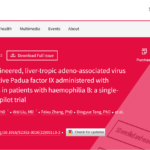In January 2024, a study led by Professor Ting Niu from West China Hospital, Sichuan University was published in the international academic journal ——Signal Transduction And Targeted Therapy (IF=38.104). The title of the study is "Fc receptor-like 5 (FCRL5)-directed CAR-T cells exhibit antitumor activity against multiple myeloma". This study sheds light on the promising potential of FCRL5-directed CAR-T cell therapy in the treatment of multiple myeloma (MM).Multiple myeloma (MM) remains a challenging hematological malignancy, despite advancements in treatment modalities such as Chimeric Antigen Receptor T-cell (CAR-T) therapy. A novel approach involving FCRL5-directed CAR-T cells, augmented with Interleukin-15 (IL-15), has shown promising results in addressing the limitations associated with antigen loss in MM. This study aimed to evaluate the cytotoxicity and therapeutic potential of FCRL5-directed CAR-T cells both in vitro and in vivo, with a focus on MM characterized by gain of chromosome 1q21. Results demonstrated potent anti-tumor efficacy in vitro and significant tumor suppression in vivo, particularly with CAR-T cells incorporating IL-15. The incorporation of IL-15 enhanced T cell persistence and functionality, leading to superior antitumor activity.
Despite significant advancements in MM treatment, the disease remains persistent, necessitating the exploration of innovative therapeutic approaches. CAR-T therapy has emerged as a promising strategy, but challenges persist, including antigen loss. The novel FCRL5-directed CAR-T cells, combined with IL-15, present a potential solution to this issue by enhancing T cell functionality and persistence.
The findings revealed robust anti-tumor efficacy of FCRL5-directed CAR-T cells both in vitro and in vivo. In vitro assays demonstrated significant suppression of MM cell proliferation, while in vivo experiments showcased substantial tumor suppression. Notably, CAR-T cells incorporating IL-15 exhibited enhanced survival rates and superior antitumor activity compared to their counterparts lacking IL-15. These results underscore the potential of FCRL5-directed CAR-T therapy, particularly when augmented with IL-15, in the treatment of MM.

(Signal Transduct Target Ther . 2024 Jan 12;9(1):16. )
The methodological approach adopted in this study was comprehensive and rigorous. In vitro assays involved detailed co-culture systems to assess cytotoxicity, with meticulous attention to experimental controls and replicates to ensure reliability of the results. In vivo experiments utilized MM cell-derived xenograft models, providing a clinically relevant context to evaluate therapeutic efficacy. Incorporation of IL-15 into CAR-T cells was meticulously executed, with thorough characterization of T cell subtypes and apoptotic rates. Statistical analyses were robust, employing appropriate tests to assess significance and ensure the validity of the findings. Overall, the methodological rigor of the study enhances the confidence in the reported results and their implications for MM therapy.
FCRL5 expression exhibited consistency even in settings of reduced BCMA expression, highlighting its viability as a stable target for CAR-T therapy. Flow cytometry and UMAP analyses further validated FCRL5 expression patterns on myeloma cells, emphasizing its potential as a viable therapeutic target. These findings underscore the significance of FCRL5 as a promising candidate for CAR-T cell therapy in MM, particularly in addressing challenges associated with antigen loss.
The study demonstrated that FCRL5-directed CAR-T cells effectively suppressed MM cell proliferation in vitro and significantly reduced tumor volume in vivo. These results underscore FCRL5 as a promising target for CAR-T cell therapy in MM, offering potential solutions to antigen loss-associated relapses. The robust cytotoxicity observed further emphasizes the therapeutic potential of FCRL5-directed CAR-T cells in MM treatment.
The study’s findings highlight FCRL5 as a promising target for CAR-T cell therapy in MM, with implications for addressing antigen loss-associated relapses. The incorporation of IL-15 represents a significant advancement, suggesting enhanced T cell functionality and comprehensive alterations to MM treatment approaches. These results underscore the potential of FCRL5-directed CAR-T cells, augmented with IL-15, to revolutionize MM treatment strategies, offering hope for improved patient outcomes and addressing challenges associated with antigen loss.
This study offers significant insights into the potential of FCRL5-directed CAR-T cells in MM treatment, highlighting the importance of IL-15 incorporation for enhanced efficacy. Further research in this direction holds promise for personalized MM therapies and improved patient outcomes.
In conclusion, this study sheds light on the promising potential of FCRL5-directed CAR-T cell therapy in the treatment of multiple myeloma (MM). Through rigorous methodology incorporating IL-15 incorporation and comprehensive evaluation using in vitro and in vivo models, the study demonstrates the efficacy of FCRL5-directed CAR-T cells in suppressing MM cell proliferation and reducing tumor volume. The consistency of FCRL5 expression, even in settings of reduced BCMA expression, underscores its viability as a stable therapeutic target. Additionally, the incorporation of IL-15 enhances T cell functionality, offering a promising avenue to address challenges associated with antigen loss in MM treatment.


